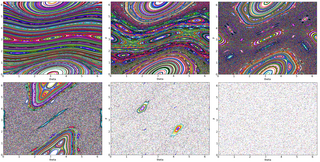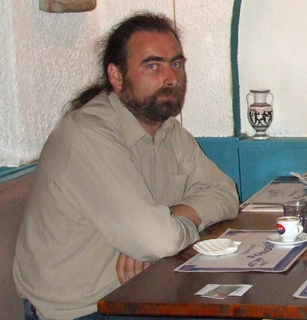
In physics, a squeezed coherent state is a quantum state that is usually described by two non-commuting observables having continuous spectra of eigenvalues. Examples are position and momentum of a particle, and the (dimension-less) electric field in the amplitude and in the mode of a light wave. The product of the standard deviations of two such operators obeys the uncertainty principle:

In physics, dephasing is a mechanism that recovers classical behaviour from a quantum system. It refers to the ways in which coherence caused by perturbation decays over time, and the system returns to the state before perturbation. It is an important effect in molecular and atomic spectroscopy, and in the condensed matter physics of mesoscopic devices.

The Belle experiment was a particle physics experiment conducted by the Belle Collaboration, an international collaboration of more than 400 physicists and engineers, at the High Energy Accelerator Research Organisation (KEK) in Tsukuba, Ibaraki Prefecture, Japan. The experiment ran from 1999 to 2010.

A quantum point contact (QPC) is a narrow constriction between two wide electrically conducting regions, of a width comparable to the electronic wavelength.
Spin-polarized scanning tunneling microscopy (SP-STM) is a type of scanning tunneling microscope (STM) that can provide detailed information of magnetic phenomena on the single-atom scale additional to the atomic topography gained with STM. SP-STM opened a novel approach to static and dynamic magnetic processes as precise investigations of domain walls in ferromagnetic and antiferromagnetic systems, as well as thermal and current-induced switching of nanomagnetic particles.
In solid-state physics, heavy fermion materials are a specific type of intermetallic compound, containing elements with 4f or 5f electrons in unfilled electron bands. Electrons are one type of fermion, and when they are found in such materials, they are sometimes referred to as heavy electrons. Heavy fermion materials have a low-temperature specific heat whose linear term is up to 1000 times larger than the value expected from the free electron model. The properties of the heavy fermion compounds often derive from the partly filled f-orbitals of rare-earth or actinide ions, which behave like localized magnetic moments. The name "heavy fermion" comes from the fact that the fermion behaves as if it has an effective mass greater than its rest mass. In the case of electrons, below a characteristic temperature (typically 10 K), the conduction electrons in these metallic compounds behave as if they had an effective mass up to 1000 times the free particle mass. This large effective mass is also reflected in a large contribution to the resistivity from electron-electron scattering via the Kadowaki–Woods ratio. Heavy fermion behavior has been found in a broad variety of states including metallic, superconducting, insulating and magnetic states. Characteristic examples are CeCu6, CeAl3, CeCu2Si2, YbAl3, UBe13 and UPt3.
As the devices continue to shrink further into the sub-100 nm range following the trend predicted by Moore’s law, the topic of thermal properties and transport in such nanoscale devices becomes increasingly important. Display of great potential by nanostructures for thermoelectric applications also motivates the studies of thermal transport in such devices. These fields, however, generate two contradictory demands: high thermal conductivity to deal with heating issues in sub-100 nm devices and low thermal conductivity for thermoelectric applications. These issues can be addressed with phonon engineering, once nanoscale thermal behaviors have been studied and understood.
Microrheology is a technique used to measure the rheological properties of a medium, such as microviscosity, via the measurement of the trajectory of a flow tracer. It is a new way of doing rheology, traditionally done using a rheometer. There are two types of microrheology: passive microrheology and active microrheology. Passive microrheology uses inherent thermal energy to move the tracers, whereas active microrheology uses externally applied forces, such as from a magnetic field or an optical tweezer, to do so. Microrheology can be further differentiated into 1- and 2-particle methods.
In physics, persistent current refers to a perpetual electric current, not requiring an external power source. Such a current is impossible in normal electrical devices, since all commonly-used conductors have a non-zero resistance, and this resistance would rapidly dissipate any such current as heat. However, in superconductors and some mesoscopic devices, persistent currents are possible and observed due to quantum effects. In resistive materials, persistent currents can appear in microscopic samples due to size effects. Persistent currents are widely used in the form of superconducting magnets.
The SP formula for the dephasing rate of a particle that moves in a fluctuating environment unifies various results that have been obtained, notably in condensed matter physics, with regard to the motion of electrons in a metal. The general case requires to take into account not only the temporal correlations but also the spatial correlations of the environmental fluctuations. These can be characterized by the spectral form factor , while the motion of the particle is characterized by its power spectrum . Consequently, at finite temperature the expression for the dephasing rate takes the following form that involves S and P functions:

The kicked rotator, also spelled as kicked rotor, is a paradigmatic model for both Hamiltonian chaos and quantum chaos. It describes a free rotating stick in an inhomogeneous "gravitation like" field that is periodically switched on in short pulses. The model is described by the Hamiltonian

In strong interaction physics, light front holography or light front holographic QCD is an approximate version of the theory of quantum chromodynamics (QCD) which results from mapping the gauge theory of QCD to a higher-dimensional anti-de Sitter space (AdS) inspired by the AdS/CFT correspondence proposed for string theory. This procedure makes it possible to find analytic solutions in situations where strong coupling occurs, improving predictions of the masses of hadrons and their internal structure revealed by high-energy accelerator experiments. The most widely used approach to finding approximate solutions to the QCD equations, lattice QCD, has had many successful applications; however, it is a numerical approach formulated in Euclidean space rather than physical Minkowski space-time.
The Aharonov–Casher effect is a quantum mechanical phenomenon predicted in 1984 by Yakir Aharonov and Aharon Casher, in which a traveling magnetic dipole is affected by an electric field. It is dual to the Aharonov–Bohm effect, in which the quantum phase of a charged particle depends upon which side of a magnetic flux tube it comes through. In the Aharonov–Casher effect, the particle has a magnetic moment and the tubes are charged instead. It was observed in a gravitational neutron interferometer in 1989 and later by fluxon interference of magnetic vortices in Josephson junctions. It has also been seen with electrons and atoms.

Yaroslav Mikhaylovich Blanter is a Russian physicist, an expert in the field of extractive metallurgy and condensed matter physics. As of 2011, he is the Antoni van Leeuwenhoek professor at the Delft University of Technology.
Differential dynamic microscopy (DDM) is an optical technique that allows performing light scattering experiments by means of a simple optical microscope. DDM is suitable for typical soft materials such as for instance liquids or gels made of colloids, polymers and liquid crystals but also for biological materials like bacteria and cells.

Fluctuation X-ray scattering (FXS) is an X-ray scattering technique similar to small-angle X-ray scattering (SAXS), but is performed using X-ray exposures below sample rotational diffusion times. This technique, ideally performed with an ultra-bright X-ray light source, such as a free electron laser, results in data containing significantly more information as compared to traditional scattering methods.
In quantum mechanics, weak measurements are a type of quantum measurement that results in an observer obtaining very little information about the system on average, but also disturbs the state very little. From Busch's theorem the system is necessarily disturbed by the measurement. In the literature weak measurements are also known as unsharp, fuzzy, dull, noisy, approximate, and gentle measurements. Additionally weak measurements are often confused with the distinct but related concept of the weak value.
Boson sampling is a restricted model of non-universal quantum computation introduced by Scott Aaronson and Alex Arkhipov after the original work of L. Troyansky and Naftali Tishby, that explored possible usage of boson scattering to evaluate expectation values of permanents of matrices. The model consists of sampling from the probability distribution of identical bosons scattered by a linear interferometer. Although the problem is well defined for any bosonic particles, its photonic version is currently considered as the most promising platform for a scalable implementation of a boson sampling device, which makes it a non-universal approach to linear optical quantum computing. Moreover, while not universal, the boson sampling scheme is strongly believed to implement computing tasks which are hard to implement with classical computers by using far fewer physical resources than a full linear-optical quantum computing setup. This advantage makes it an ideal candidate for demonstrating the power of quantum computation in the near term.

Graphene is a semimetal whose conduction and valence bands meet at the Dirac points, which are six locations in momentum space, the vertices of its hexagonal Brillouin zone, divided into two non-equivalent sets of three points. The two sets are labeled K and K'. The sets give graphene a valley degeneracy of gv = 2. By contrast, for traditional semiconductors the primary point of interest is generally Γ, where momentum is zero. Four electronic properties separate it from other condensed matter systems.
Quantum optical coherence tomography (Q-OCT) is an imaging technique that uses nonclassical (quantum) light sources to generate high-resolution images based on the Hong-Ou-Mandel effect (HOM). Q-OCT is similar to conventional OCT but uses a fourth-order interferometer that incorporates two photodetectors rather than a second-order interferometer with a single photodetector. The primary advantage of Q-OCT over OCT is insensitivity to even-order dispersion in multi-layered and scattering media.














